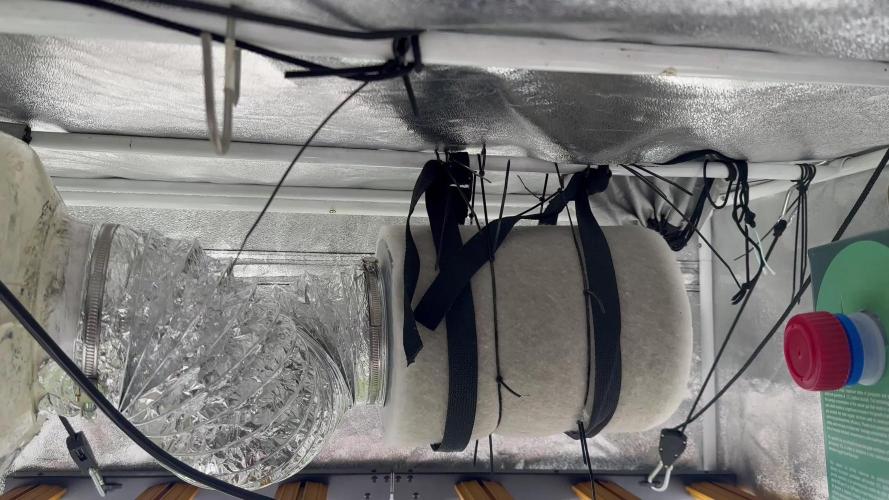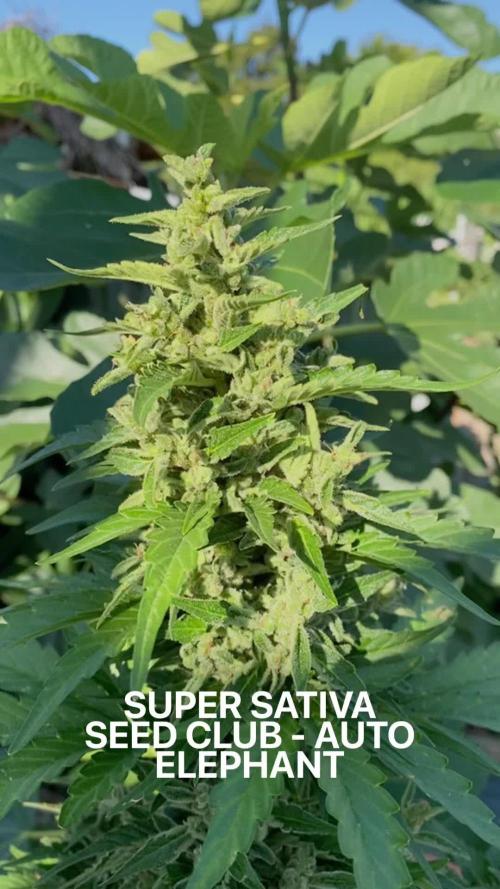The Grow Awards 2026 🏆 





































Likes
Comments
Share


@MadeInGermany
Follow
Flowering day 48
since time change
to 12 / 12 h
Hey guys It's such a beautiful sight every day 💚.
The buds develop great and smell delicious 😃
Watering was done twice this week with 1.2 l each
The tent was cleaned and each lady examined individually :-).
Have fun with the update and stay healthy 💚🙏🏻
👇🏼👇🏼👇🏼👇🏼👇🏼👇🏼👇🏼👇🏼👇🏼👇🏼👇🏼👇🏼
‘Powered by GreenHouse Feeding’
Copy the link for 10% off all Nutrients 👇🏼
https://shop.greenhousefeeding.com/affiliate/MadeInGermany_PassionGrower
👇🏼👇🏼👇🏼👇🏼👇🏼👇🏼👇🏼👇🏼👇🏼👇🏼👇🏼👇🏼
You can buy this strain at :
https://www.amsterdamgenetics.com/product/choco-cheesecake/
👇🏼👇🏼👇🏼
Use the coupon code: madeingermany
for 10% on all Amsterdam Genetics seeds
Water 💧 💧💧
Osmosis water mixed with Cal/Mag (24 hours stale that the chlorine evaporates) to 290 ppm and Ph with Ph- to 5.8 - 6.4
MadeInGermany
Likes
3
Share


@FireAntTheGrower
Follow
Lava Cake , I had to grow it because from what I hear people say Lava Cake isn’t all that. I actually like it. We did my girl and I smoke test it . lol said make her horny smh 🤦🏾♂️ not only that I got female growmies saying Lava Cake her favorite strain. Sweet and earthy .
Likes
9
Share


@Orchydis
Follow
I use a tent 90x60x180, I put my lamp at 1 m and at 50% only, I use cotton disks for the germination, I’m gonna change #4 with #10 I think because she seems in bad health.
Likes
7
Share


@100Trillion
Follow
Grow is going complete well. Plants are maturing quite fast and frosting up tremendously. Smell are getting strong as the grow can now be smelt outside of my home. (No carbon filter needed). About to more weeks before harvest and it seems like the plant are starting to senes slowing. Starting to see light shades of purple of the leaves.
Likes
Comments
Share


@I_roll_my_own_420
Follow
Hey. I have done first scrog training day 5 of 12/12 light schedule. Looks good. Also, I added co2 box on the bottom of tent and use fan to move it around plants.
Likes
16
Share


@the_medicine_grow_uk
Follow
All done and dusted on this bad boy. Nice big bushy auto that did its job from the beginning. It was always harder work than the Do Si Dos and with what I’ve hung up to dry I don’t think it’ll have a larger harvest either. The smell is super strong and very fruity and will give an updated the final smoke and weight. 🙌🏼
Likes
48
Share


@Regenwurm
Follow
Klima durchweg sehr gut. Aufgrund von dem Umtopfen nur 2 mal reines Regenwasser und 1 mal Zusätze von Green Buzz. Den Ladies geht es auch ohne Dünger in dieser Phase hervorragend. Den Haupstamm HST um die Seitenteilen zu puschen. Lichtstärke auf 35 % erhöht bei gleichem Abstand von rd. 40 cm. Heute Licht auf 40 % erhöht.
Ventilator im Zelt umgebaut um mehr Fläche zu generieren. In den nächsten Tagen wird das erste mal etwas grober entlaubt.
Likes
17
Share


@DevelGrow
Follow
Hallo Freunde 👋 Frost Banger von fast buds ist 56 Tage Alt und baut mächtige buds! Ein starker süß erdiger Geruch im Zelt bin echt neugierig was sie in zwei Wochen noch zu bieten hat! Keep Green and grow High ✌️🍀💚🍀
Likes
6
Share


@DailyhighclubNLyara
Follow
De Daily High Club is niet voor niks even weg geweest, achter de schermen zijn we ontzettend druk bezig om de content van onze members te verzamelen, te bewerken en al het materiaal tot zijn recht te laten komen. Als team zijn we hier ontzettend druk mee bezig maar als club houden we hiervan, we zijn dankbaar dat we samen met jullie de community een stukje leuker en beter te maken. We krijgen alleen maar Love van onze members en we zijn jullie ontzettend dankbaar. Welkom bij de Club!
Deze grow is een van de test grows van Yaramang, hij zal onze voornaamste grower zijn. Hij is net als velen van jullie verliefd geraakt op de hobby en we vinden het leuk deze samenwerking te mogen aankondigen met hem. Voor deze Grow hebben we Mephisto Genetics zaadjes besteld (zij zijn 1 van de eerste seedbanks die Autoflower zaden produceerde met ontzettend hoge THC-gehaltes van boven de 20%, wij wilden onze Nederlandse Growers hier wel eens van laten genieten. Autoflowers blijven ontzettend makkelijk en uit ervaring horen we dat wanneer je AF op de juiste manier kweekt je er genoeg groen plezier van zult hebben!
Heel veel plezier van de eerste test-grow van Yaramang.
Powered by Daily High Club
Zoals iedere kweek begin ik met de koffie filter techniek. Ik pak een simpele koffiefilter van de Aldi, (ander merk werkt waarschijnlijk ook) maak deze volledig nat door hem 1 keer heen en weer te halen onder de kaart en doe het zaadje met de punt naar beneden (of iets wat zo veel mogelijk op een punt lijkt, ervaring blijkt dat 25% alsnog verkeer omzit en het zonder problemen overleefd) en vouw de koffiefilter dicht maar niet dat de vouwrand tegen het zaadje aankomt. De filter stop ik in een huishoudzakje die je kunt sluiten en sluit deze voor ongeveer 75% met de koffiefilter erin. Dit zakje leg ik in een donkere doos (zo'n "luxe" schuifdoos van Apple want die is helemaal donker) met de deksel erop en die doe ik in een donkere nachtkastje. Om de temperatuur te meten heb ik een temperatuur meter in hetzelfde doosje gelegd. Om de perfecte geadviseerde temperatuur tussen de 23-26 graden te hebben leg ik mijn Deco (modem) onder de doos zodat het doosje eigenlijk constant de perfecte temperatuur van 25 graden heeft. Na de eerste dag zag ik al een paar witte puntjes verschijnen door eventjes met een lamp door de filter en het zakje heen te kijken en binnen 48 uur zie je al dat de wortel zo'n 1 tot soms wel 3cm al is. Wanneer het witte worteltje ongeveer zo groot is als een vingertop is het tijd om te zaaien.
Likes
17
Share


@Comfrey
Follow
Leider musste ich auf einer unteren Blüte Kot von irgend einem Tier entfernen. Ich vermute dass es eine Weinbergschnecke war. Oder hat von euch jemand eine Idee? Nicht das am Ende jemand Rattengift darauf verteilt hat. Ich bin mir nicht sicher was das sein könnte.
Ansonsten entwickelt sie sich sehr schön weiter. Der Duft ist wirklich sehr angenehm.
Likes
36
Share


@ganjameister
Follow
Flowering Day 56
Fade treating is going on and Kmintz is starting to show its true colours. The smells is getting more intense every day! Harvest in likely one week
Likes
142
Share


@MadeInGermany
Follow
Hi everyone 🤗.
The end of the last remaining women is slowly approaching 😍.
They all look beautiful and will all be ready in the next 6 - 12 days 😎.
I am very excited about the tastes 😍.
I wish you a lot of fun with the diary, stay healthy 🙏🏻 and let it grow 🌱😎
Likes
39
Share


@KnightRider
Follow
Hey Cannafam,
Well weve reached the end for this gorgeous gal, i did want to leave her another week but ive been informed that my landlord wants to inspect the property in 2 weeks, so shes come down and needs to be dried jarred and the tent put away!
In the final week i managed to flush her and the light was dailed down to 56%(61 watts). Again humidity was high at 70% with 23c temp, VPD of 0.84 and DLI at 35.
Although i was not able to control the environment completley in her final weeks, this gal has performed like a champ, she has built solidly throughout with a maximum of 80 watts from my little rig so a really energy efficient grow 😊
Trimming was very difficult, as she was so low down ive wet trimmed in the pot some and then had to dig to cut her main stem. She was just one massive brick of bud when i took her down 😁 and i must say i definitely fell in love with this chunky woman. Further trimming will be done when shes dried out more and il update with the final dry weight and smoke report later.
I hope you've enjoyed this diary, stay safe and remember the Sun always shines in Space 😊✌️💚💚💚
Likes
11
Share


@tangie
Follow
I have started flushing with pH-adjusted Flawless Finish solution, expecting to harvest somewhere around the end of this week, although I will continue monitoring pistils and trichs.
Upd: Added back 50% base nutrients and some flowering additives after researching some of the first responses to my flushing question. I learn every day. Even that which was scientifically proven true one day, might be even more scientifically proven absolutely false some time later (not related to flushing specifically).
Thank you kings!
Upd 2: Okay okay I cooked her with some cosmic rays or whatever those Chinese quantum bars emit — purple rays, I'll call it — that's on me. Turned them 30% down to see what's up. Light burn was not on my mind, because otherwise the leaves were not really curving that much, considering that this is 3 weeks overdue wrt advertised. Sorry about that, did not pay enough attention.
Likes
2
Share


@EtnoGrow
Follow
bueno se hizo una por primera vez una cosecha por partes, como indicamos en el post anterior, se cosecho los cogollos donde la luz pegaba mas al parecer y estaban mas desarrollados, la cosecha fue con tricomas blancos tendiendo a transparentes con pocos ambar, en opinion ya luego de una semanas y una segunda cosecha, es que cosechamos pronto por temor al pasarnos al ser primera vez, entonces posiblemente nos apresuramos un poco ligeramente o confundimos los tricomas tendiendo a ser transparente por los blancos que es lo que indica la teoria el punto de corte, pero no nso quejamos quedo genial! subiremos el segundo punto de corte luego de 2 semanas . LAS ULTIMAS FOTOS LAS DE LAS 2 SEMANAS MAS 2DO CORTE.
Likes
41
Share


@PersonalSmok3s
Follow
All appeared well with this Lady until yesterday 🤦♂️🤷♂️
I noticed a small discoloured patch on one of the top buds, it had the start of what appeared to be bud rot 😿
Asked a couple of mates their opinion and we’ve all come to the same conclusion.
I’ve checked the rest of the plant and can’t see any signs of any more. She’s meant to be coming down in 7 days, but that may have to be pushed forward.
I’ve bought some more fans (5 to be precise) they should arrive today, so hopefully that should help. I’ve needed to upgrade my fans for a while, wish I’d sorted it out sooner.
I’ve added a video at the end showing the bud in question.
Don’t be surprised if this diary updates as finished in the next few days, until next time 🌱💚
Likes
9
Share


@GrowPassionItalyChris
Follow
Sono felice di tutte e 4 le banche semi che mi hanno regalato qualche seme alla fiera canapa mundi di Roma, già in passato ho sempre provato casualmente tantissime varietà,sono affezionato ad una banca semi in particolare ma voglio bene a tutti. Queste varietà sono fino ad adesso perfette per le mie esigenze perché crescono facili,rapide e molto resistenti e sono già in fioritura! Ogni varietà si sta sviluppando in maniera impeccabile e sono molto felice perché hanno resistito ai cambiamenti climatici e stanno resistendo benissimo la presenza di afidi sotto le foglie, ogni settimana stiamo utilizzando olio di piretro ad azione rapida e sta funzionando. Il colorito della piante ed il vigore che hanno nel crescere e fiorire è dimostrato nel video e nelle foto! Hanno avuto una crescita molto rapida in questa settimana. Il clima è migliorato e le temperature sono di tipo estive quindi non faranno che migliorare. Io coltivo in maniera biologica e non uso potature particolari e queste varietà sembrano ideali per me. Affinché avrò la passione di coltivare sicuramente useremo anche queste varietà perché questo 2023 in Italia il clima è stato pessimo durante le prime 3 settimane di vita di queste varietà e hanno resistito a grandine,pioggia e sbalzi di temperatura. Iniziano a fiorire ed il caldo estivo ormai è arrivato! Un abbraccio a tutti
Likes
16
Share


@Boomdrawfyah
Follow
27 dias de vida, la siembra este año ha empezado muy tarde ya que queriamos colaborar con las semillas test de Paradise Seeds , pero la buena calidad de semillas y la tabla que nos envió Terranabis pra trabajar una buena nutrición y elicitación haran que se haga notar!! Estan muy buen servidas vamos a ver como crecen !!!
Estos son los unicos datos que dispongo de las variedades :
-1051 Variedad indica de tamaño pequeño
-3951 hibrida
-4251 Variedad muy alta con predominancia Sativa
-3551 variedad hibrida cruzada con skunk, vegetacion rapida y color morado
Processing
Likes
17
Share


@greennug
Follow
plants looking great dinafem standing out from the crowd.my stardawg cuttings are thriving and a few of the fastbuds strains look beautiful.should be kicking into flower late next week. daily updates until harvest!























